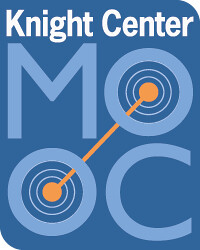

It’s been a little over a year since the Knight Center for Journalism in the Americas launched its innovative Massive Open Online Course (or MOOC) initiative and, in that time, the program has offered a total of seven massive courses and reached 27,674 people in more than 150 countries. The Knight Center’s MOOC website was visited, during this period, 349,273 times and delivered 3,055,506 pages.
Despite its young age and low-budget structure, the initiative has been a resounding success. In numerous student reviews, the Knight Center’s program has been repeatedly praised for its quality and effectiveness.
Cutting-edge skills in the use of digital tools to improve the quality of journalism have been brought to people in most countries of the world, including regions where that kind of training would not be available otherwise. And even though a small fee has been charged when participants request for a certificate of completion, all the courses were offered for free and anyone from anywhere in the world could access the courses without any payment.
“Teaching journalism skills to massive classes of thousands of people from dozens of countries has been a fascinating experience for the instructors and for all of us here at the Knight Center,” said Professor Rosental Alves, founder and director of the Knight Center. “We have been navigating uncharted waters and still have a lot to learn and improve, but we have already come to the realization that these are not just traditional classes. Each MOOC becomes an engaged, interactive and dynamic learning community where people from different cultures, countries and continents come together to learn from each other in a new way.”

On Nov. 18 the Knight Center launched with the support of Google its most recent MOOC, “Development of Journalistic Projects for the Web: an Introduction to Entrepreneurial Journalism,” with instructor Janine Warner. With more than 5,270 students, this course in Spanish has already become the program’s most popular MOOC and attracted the largest number of Latin American students of any other Knight Center class.
The Knight Center’s first MOOC, “Introduction to Infographics and Data Visualization” with instructor Alberto Cairo, was offered for the first time in October 2012 and demonstrated the program’s potential. The course was the world’s first MOOC in journalism and was so well received that the Knight Center has offered two more editions of the class since then, one in January this year and another in October. Combined, the three editions of Cairo’s course have reached more than 11,000 students around the world.

“When I accepted to conduct a third edition of this MOOC, I didn’t foresee that we would attract so many students,” Cairo said. “After all, we had 2,000 on the first one and 5,000 on the second one. I’m not complaining, of course. Quite the contrary. I guess that the success of this third edition proves that the MOOC model has a very promising future – even considering that it still has a lot of progress to make – and that the appetite to learn data-driven storytelling, visualization, and infographics intro-level skills has not diminished, but it’s increasing at an accelerating pace.”
In March 2013, the Knight Center offered its first MOOC in Spanish, “How to Improve Electoral Coverage,” which was taught by award-winning Colombian journalist María Teresa Ronderos. The course was followed by another massive online course in Spanish, “Introduction to Data Journalism,” with renowned Argentine journalist Sandra Crucianelli. The MOOC attracted almost 4,000 students in 62 countries.

And in August this year, the Knight Center offered “Data-Driven Journalism: The Basics,” which concluded with 3,7000 participants in 143 countries. The course was taught by five of the leading data journalism experts in the United States and represented the first time the Knight Center invited several instructors to teach one course.
“The data-driven journalism MOOC was a great opportunity,” said Amy Schmitz Weiss, an an associate journalism professor at San Diego State University and overall coordinator of the massive course. “We had an amazing team of instructors, fantastic learning materials and content created by the instructors, and eager, excited learners which made the MOOC a success. I am so glad that so many students enjoyed the experience and were able to take away some valuable data skills in the process.”
The Knight Center’s MOOC program has successfully pushed the boundaries of the massive online course format and proven that dynamic interactions are not only possible in online classes with thousands of participants, but also enrich the students’ experience significantly.
While most massive online courses are college classes that have been recorded on video and adapted to be shared over the Internet, the Knight Center’s MOOCs have been specifically designed to emphasize student interactions and collaborations. Through the courses’ online forums, instructors are constantly answering questions and making general comments about students’ work, while students are encouraged to discuss their assignments and help each other.
Since it launched its pioneering Distance Learning program in 2003, the Knight Center has also offered 120 traditional online courses and trained 7,327 journalists across all Spanish-speaking countries.
The Knight Center for Journalism in the Americas was created in 2002 by Professor Rosental Alves, who holds the Knight Chair in Journalism and the UNESCO Chair in Communication at the University of Texas at Austin School of Journalism. Launched with major, multi-year grants from the John S. and James L. Knight Foundation, the Center also has received grants from Open Society Foundations and other donors. The Knight Center also has been sustained with support from the University of Texas at Austin’s College of Communication, modest foundation grants and the public.

Knight Center for Journalism in the Americas
300 West Dean Keeton
Room 3.212
Austin, TX, 78712
Phone: 512-471-1391
Email: journalismcourses@austin.utexas.edu